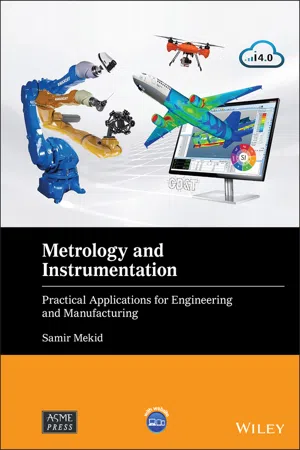
eBook - ePub
Metrology and Instrumentation
Practical Applications for Engineering and Manufacturing
Samir Mekid
This is a test
Partager le livre
- English
- ePUB (adapté aux mobiles)
- Disponible sur iOS et Android
eBook - ePub
Metrology and Instrumentation
Practical Applications for Engineering and Manufacturing
Samir Mekid
Détails du livre
Aperçu du livre
Table des matières
Citations
À propos de ce livre
Metrology and Instrumentation: Practical Applications for Engineering and Manufacturing provides students and professionals with an accessible foundation in the metrology techniques, instruments, and governing standards used in mechanical engineering and manufacturing. The book opens with an overview of metrology units and scale, then moves on to explain topics such as sources of error, calibration systems, uncertainty, and dimensional, mechanical, and thermodynamic measurement systems. A chapter on tolerance stack-ups covers GD&T, ASME Y14.5-2018, and the ISO standard for general tolerances, while a chapter on digital measurements connects metrology to newer, Industry 4.0 applications.
Foire aux questions
Comment puis-je résilier mon abonnement ?
Il vous suffit de vous rendre dans la section compte dans paramètres et de cliquer sur « Résilier l’abonnement ». C’est aussi simple que cela ! Une fois que vous aurez résilié votre abonnement, il restera actif pour le reste de la période pour laquelle vous avez payé. Découvrez-en plus ici.
Puis-je / comment puis-je télécharger des livres ?
Pour le moment, tous nos livres en format ePub adaptés aux mobiles peuvent être téléchargés via l’application. La plupart de nos PDF sont également disponibles en téléchargement et les autres seront téléchargeables très prochainement. Découvrez-en plus ici.
Quelle est la différence entre les formules tarifaires ?
Les deux abonnements vous donnent un accès complet à la bibliothèque et à toutes les fonctionnalités de Perlego. Les seules différences sont les tarifs ainsi que la période d’abonnement : avec l’abonnement annuel, vous économiserez environ 30 % par rapport à 12 mois d’abonnement mensuel.
Qu’est-ce que Perlego ?
Nous sommes un service d’abonnement à des ouvrages universitaires en ligne, où vous pouvez accéder à toute une bibliothèque pour un prix inférieur à celui d’un seul livre par mois. Avec plus d’un million de livres sur plus de 1 000 sujets, nous avons ce qu’il vous faut ! Découvrez-en plus ici.
Prenez-vous en charge la synthèse vocale ?
Recherchez le symbole Écouter sur votre prochain livre pour voir si vous pouvez l’écouter. L’outil Écouter lit le texte à haute voix pour vous, en surlignant le passage qui est en cours de lecture. Vous pouvez le mettre sur pause, l’accélérer ou le ralentir. Découvrez-en plus ici.
Est-ce que Metrology and Instrumentation est un PDF/ePUB en ligne ?
Oui, vous pouvez accéder à Metrology and Instrumentation par Samir Mekid en format PDF et/ou ePUB ainsi qu’à d’autres livres populaires dans Tecnologia e ingegneria et Ingegneria meccanica. Nous disposons de plus d’un million d’ouvrages à découvrir dans notre catalogue.
Informations
1
Fundamental Units and Constants in Metrology
“When you can measure what you are speaking about and express it in numbers, you know something about it.”—Lord Kelvin (1883). Source: Public Domain.
1.1 Introduction
Metrology is the science of measurement with various applications. It is derived from the Greek words metro – measurement and Logy – science. The BIMP (Bureau of Weights and Measures in France) defines metrology as “the science of measurement embracing both experimental and theoretical determinations at any level of uncertainty in any field of science and technology.”
Five pivots define the functions of metrology:
- To establish the units of measurements;
- To replicate these units as standards;
- To guarantee the measurement uniformity;
- To develop measurement methods;
- To investigate the accuracy of methods‐related errors.
Based on this, the objectives of metrology are:
- Selection of proper measuring instrument;
- Proper measuring standards;
- Minimizing inspection cost;
- Defining process capabilities;
- Standardization;
- Maintaining accuracy and precision during inspection or as component of an instrument over time of use [1].
Therefore, two types of metrology exist:
- Deterministic, or industrial, metrology.
- Legal, or scientific, metrology.
Measurement is the process of revealing a single or multiple values to the characteristics of an object or property by conducting experiments to determine the value of this particular property. These properties may be physical, mechanical, or chemical, such as length, weight, force, strain, volume, angle, and molls.

Figure 1.1 Simplified methodology producing measurement results.
Metrology also includes precision, repeatability, and accuracy, which refers to how accurate the measured value is. It establishes a well‐known understanding of the measuring process and the related units that are critical in connecting various human activities and ensures that these measurements are linked to reference standards, which is commonly referred to as traceability. For as long as civilization has existed, measurements have been taken. It is necessary for a country's economic and social development. It provides precise measurements that have an impact on the economy, health, safety, and general well‐being. It could also be a legal problem. As a result, the topic is always in demand.
This chapter will introduce the fundamental units and constants in metrology through conversions between units and systems. To put measurements into context, a complete methodology of the act of measurement beginning with the object to measure and ending with the result that constitutes the information needed for the object is required. The complete process is summarized in Figure 1.1. The figure depicts a simplified methodology for producing measurement results with minimal conditions such as the units to be known, the calibration of the measurement instruments, and the uncertainty of su...